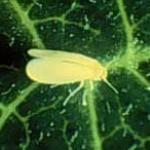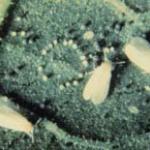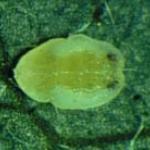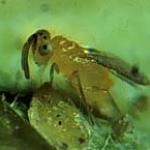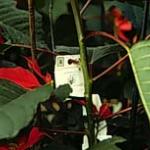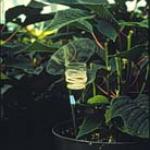Biological Control: A Grower's Guide to Using Biological Control for Silverleaf Whitefly on Poinsettias in the Northeast United States
The Pest: Silverleaf Whitefly, Bemisia argentifolii
Historical Review.
The major foliar pest of poinsettia in northeastern United States greenhouses is the silverleaf whitefly (SLW), Bemisia argentifolii. This insect first became a greenhouse pest in the northeast United States in 1987 when it became more common than the greenhouse whitefly (GHWF) (Trialeurodes vaporariorum), the primary whitefly pest of poinsettia at that time. The current problem with SLW began in 1986 when poinsettia growers in Florida experienced devastating outbreaks of what was at first called sweetpotato whitefly (SPWF), Bemisia tabaci. SPWF had been in the United States since 1897. To distinguish this new, damaging form of SPWF, from the pre-existing, less damaging strain, the old strain was referred to as strain A, and the new strain damaging poinsettia, field crops, and vegetables, was called strain B. By 1987-88, strain B had spread to almost every poinsettia growing region in the United States.
Work on the biology, morphology, and genetics of strains A and B revealed sufficient difference that strain B was described as a new species of whitefly. Strain B was named Bemisia argentifolii, the silverleaf whitefly, because of its ability to cause squash silverleaf. The exact country of origin of SLW is unknown, but it is thought to be the Middle East.
Pest Identification.
An important step in any pest management program is the accurate identification of the pest. This is particularly true for biological control because natural enemies are often specific to just one pest or group of pests, e.g., whiteflies. Adults and pupae of SLW are readily distinguishable from those of GHWF. Adults of SLW are smaller than those of GHWF, are more active, and hold their wings in a tent like fashion against the sides of the abdomen (Fig. 1). Adults of GHWF hold their wings flat over the top of the abdomen almost parallel to the leaf surface (Fig. 2).
SLW pupae are yellow with reddish colored eyes, oval in shape, and lack long waxy spines (Fig. 3). Conversely, GHWF pupae are white, have an elevated straight-sided body wall with a fringe of waxy spines (Fig. 4).
GHWF often lay their eggs in circles or semi-circles, and as the eggs mature they turn from white to dark purple in color. SLW lay their eggs haphazardly over the underside of the leaf (occasionally females will lay eggs in circles). As eggs mature they turn from white to amber.
Biology of the Pest.
SLW has four developmental stages (egg, nymphs, pupa and adult), only two of which are mobile. Eggs are laid on the undersides of leaves and from the egg emerges the crawler. This stage crawls a short distance from the egg before settling to feed. The following nymphal stages and pupal stage are immobile, and do not move from the site selected by the crawler. The adult which emerges from the pupa can walk and fly. Adults and immatures of SLW feed by sucking sap from plants. The waste product produced from feeding is called honeydew, and this may contaminate leaves and promote the growth of black sooty molds. SLW does not currently transmit any viruses which cause disease in poinsettia. Important aspects of SLW and GHWF reproductive biology are presented in Tables 1 and 2 respectively.
| Biological Attribute | Temperature: 16oC (61oF) |
Temperature: 22oC (72oF) |
Temperature: 28oC (84oF) |
|---|---|---|---|
| Average adult lifespan | 30.1 days | 22.4 days | 15.5 days |
| # eggs laid per female | 60.2 eggs | 90.9 eggs | 96.3 eggs |
| Egg to adult emergence (days) | 168.1 days | 49.9 days | 29.9 days |
| # days for eggs to hatch | 45.5 days | 16.9 days | 10.4 days |
| Biological Attribute | Temperature: 18oC (66oF) |
Temperature: 21oC (70oF) |
Temperature: 27oC (81oF) |
|---|---|---|---|
| Average adult lifespan | 42.5 days | 28.5 days | 8.3 days |
| # eggs laid per female | 319.58 eggs | 209.46 eggs | 29.5 eggs |
| Egg to adult emergence (days) | 30.04 days | 27.6 days | 21.2 days |
Commercially Available Natural Enemies for Silverleaf Whitefly Control
Encarsia formosa
This species is a tiny black and yellow wasp (~1mm in length) originally described from greenhouses in Idaho in 1924 (Fig. 5). Encarsia formosa is used to control GHWF in Europe, Canada, the United States, Australia, and New Zealand and is considered an effective biological control agent of GHWF on a variety of greenhouse vegetable crops (e.g., tomatoes).
When searching for whiteflies on leaves, E. formosa moves randomly across the leaf drumming the surface with its antennae. When a nymph is located, it is inspected by the wasp with its antennae. During this process, the wasp assesses the nymph's suitability for parasitism or host feeding. Parasitism is the act of laying an egg inside the whitefly nymph. The wasp larva that hatches from the egg feeds and pupates inside the nymph. The adult wasp chews its way out of the whitefly pupal case. Encarsia formosa reproduces without mating, and all offspring are female. Females require protein in their diet which is acquired by feeding on whitefly nymphs; this is called host feeding. Death from host feeding can be an extremely important mechanism of whitefly control. Important aspects of the reproductive biology of E. formosa are presented in Table 3.
| Wasp Biology | E. formosa reared on GHWF |
E. formosa reared on SLW |
|---|---|---|
| Preferred stage for egg laying | 3rd and 4th instar nymphs |
3rd and 4th instar nymphs |
| # eggs laid per day | 5 | 6 |
| # eggs laid per lifetime | 59 | 51 |
| Preferred stage for host feeding |
2nd instar nymphs and pupae |
2nd instar nymphs and pupae |
| # nymphs fed on per day per wasp |
3 | 2 |
| Total # nymphs killed per wasp |
95 | 69 |
| Adult wasp life expectancy | 12 days | 9 days |
| Egg to adult wasp emergence | 25 days | 30 days |
Eretmocerus eremicus
This species was formerly referred to as Eretmocerus sp. (Arizona nr californicus). It is a tiny wasp (~1mm in length) (Fig. 6) that can be found parasitizing whiteflies in the southern desert areas of California and Arizona. Eretmocerus eremicus is lemon yellow in color with green eyes and females have clubbed antennae. In commercial mass rearing facilities on greenhouse whitefly, this wasp has a sex ratio of one female to one male, unlike E. formosa which is all female.
When Eretmocerus eremicus females locate nymphs, these are inspected with the antennae and wasps either lay eggs under nymphs or host feed. After hatching from the egg, the E. eremicus larva chews its way into the whitefly nymph. After completing development, adult wasps chew their way out of the whitefly pupae. Female E. eremicus also host feed in a manner similar to E. formosa. Aspects of the reproductive biology of a related species, Eretmocerus sp. (CA) are presented in Table 4.
| Wasp Biology | Eretmocerus sp. reared on GHWF | Eretmocerus sp. reared on SLW |
|---|---|---|
| Preferred stage for egg laying | 2nd and 3rd instar nymphs |
2nd and 3rd instar nymphs |
| # eggs laid per day | 8 | 3 |
| # eggs laid per lifetime | 149 | 27 |
| Adult wasp life expectancy | 20 days | 10 days |
| Egg to adult wasp emergence | 20 days | 16 days |
Results of Trials with Parasitic Wasps to Control Silverleaf Whitefly on Poinsettia
Using Encarsia formosa
Tests in commercial greenhouses showed that release rates of one, three, and 4-7 E. formosa per plant per week did not provide adequate SLW control (Table 5). Consequently, we do not recommend the use of E. formosa as a biological control agent for SLW on poinsettias grown for stock plants, or for plants intended for the Christmas market.
Using Eretmocerus eremicus.
A release rate of 3 Eretmocerus eremicus females/plant/week caused 99.1% mortality. This level of mortality was sufficient to prevent an increase in SLW numbers for most of the growing season. Based on these results, E. eremicus appears to be the better choice for biological control of SLW on poinsettia stock plants and finished plants for sale at Christmas (Table 5).
| Release Rate of Wasp (# females/plant/week) |
% Dead (Mortality) |
% Parasitism |
|---|---|---|
| 1 Encarsia formosa/ plant/week | 95% | 13% |
| 3 Encarsia formosa/ plant/week | 92% | 23% |
| 4-7 Encarsia formosa/ plant/week | 86% | 14% |
| 1 Eretmocerus eremicus/ plant/week | 88% | 34% |
| 3 Eretmocerus eremicus/ plant/week | 99.1% | 10% |
Practical Guidelines for Biological Control of Silverleaf Whitefly on Poinsettia
If whitefly populations are SLW, based on research to date, we recommend the use of Eretmocerus eremicus. To maximize the likelihood of successful control of SLW, an effective scouting program should be developed and used. Success can be further enhanced by making use of a professional greenhouse scout and by following the steps outlined below:
1) Pre-release pest count: Before releases of Eretmocerus eremicus are made, the bottom three leaves on 50 randomly selected cuttings should be examined for SLW nymphs, pupae and adults. Ideally, the initial whitefly infestation should on average be less than 1 whitefly nymph, pupa, and adult combined per cutting inspected.
2) Pest threshold: If the initial SLW population is low (< 1 SLW nymph, pupae and adult per cutting) releases of Eretmocerus eremicus should begin immediately once cuttings have been potted. When E. eremicus is used this way, control is referred to as preventative biological control, because SLW is being suppressed by parasites before whiteflies become damaging. Parasitic wasps cannot be used in a curative manner as insecticides can once SLW have reached high densities. If initial whiteflies densities are greater than an average of one SLW nymph, pupae, or adult per cutting, alternative control measures should be followed. These may include either the use of insecticides which leave persistent residues or the use of chemicals that are compatible with biological control agents. Compatible chemicals include soaps, horticultural oils, and insect growth regulators (Table 6). Parasite releases can be made after applications of these materials have been used to reduce whitefly numbers.
Biological control should not be attempted following the use of most conventional insecticides with long (weeks) residue times (e.g., pyrethroids). Fungus gnat controls compatible with biological control for whiteflies include Nemasys, Scanmask, Gnatrol, Azatin, and Enstar II.
3) Monitoring: Once releases of Eretmocerus eremicus begin, plants should be inspected weekly to measure the effect of the parasitoid (e.g., dead and parasitized whitefly nymphs and pupae). A weekly record of the number of live nymphs, pupae and adult whiteflies in the crop should be kept. These records will indicate whether the SLW population is increasing, decreasing or remaining stable. An IPM scout may be employed to perform the monitoring. Should whitefly nymphs begin to increase to a level that is unacceptable, a biorational insecticide that is compatible with parasitoids should be used (e.g., Table 6). Trends in whitefly pupae are of greatest value in detecting the onset of periods of rapid population increase. Whitefly monitoring must continue for the entire cropping season.
4) Assessing parasite quality: Eretmocerus eremicus will be shipped by a supplier as parasitized GHWF pupae mixed in sawdust. Commercial vendors of this species will probably call it either Eretmocerus sp. or Eretmocerus californicus. The name Eretmocerus eremicus is new (1997). Samples of recently purchased material should be examined periodically to ensure that wasps are arriving in good condition and are emerging. This can be done by placing some of the sawdust containing the parasitized whitefly pupae in a small clear jar which is kept in a shady place. Observe the number of wasps that emerge into the jar over a 5-7 day period. If a lot of wasps are seen, the shipment can be assumed to have arrived in good condition. If few wasps are seen, inform the supplier that shipment quality was poor and order more wasps. We have found that after shipping and placement in the greenhouse, E. eremicus emergence averages 60%.
| Type of Pesticide | Target Pest | Pesticide Trade Name | Pesticide Common Name |
|---|---|---|---|
| Insecticides | fungus gnat | Gnatrol | Bacillus thuringiensis |
| caterpillars | Dipel | Bacillus thuringiensis | |
| whiteflies | Enstar II | kinoprene1* | |
| " | Neemix and Azatin | azadirachtin (neem) | |
| " | M-Pede | soap | |
| " | Avid | abamectin | |
| " | Ultra-Pure Oil | horticultural oil (mineral oil) | |
| Fungicides | Plant Diseases | Subdue | metalaxyl |
| " | Daconil | chlorothalonii | |
| " | Chipco | iprodione | |
| *kinoprene1 -- may show phytotoxicity | |||
5) Calculating the number to release: Eretmocerus eremicus is sold as pupae mixed with sawdust, with 3000 pupae per bottle. Release rates are described in terms of numbers of adult female wasps per plant. Three release rates may be used: high (3 females/pl/wk), medium (2 females/pl/wk) or low (1 female/pl/wk). To calculate the number of pupae to order per week for a greenhouse, multiply the number of plants by 10 for the high release rate, by 7 for the medium rate, and by 3.5 for the low release rate. These conversion factors incorporate the expectations that 50% of the pupae are female, and that 60% of all pupae will successfully emerge. For example, for 3,000 plants, if you want to use the high release rate, order 30,000 pupae/wk. If you want to use the low release rate, order 10,400 pupae.
Our field trials in commercial greenhouses in Massachusetts in 1995 and 1996 have shown that weekly releases at the high rate from potting to sale provides effective whitefly suppression of both SLW and GHWF on poinsettia without using insecticides provided no management mistakes are made. Mistakes that have been observed to reduce control from wasp releases include: (1) immigration of large numbers of adult whiteflies into the biological control greenhouse from compost piles through air vents, (2) introduction of older, heavily infested plants from other greenhouses in the crop, (3) watering practices that cause the wasp pupae to get wet (mainly overhead watering such that sawdust in cups is wetted), (4) excessive ventilation in hot weather such that emerging wasps are sucked out of the greenhouse, and (5) application of foliar applied insecticides.
If these practices are avoided, use of the high release rate will provide control. Lower release rates (used to reduce cost, see section 7) below) are less effective. If parasites are released at the medium or low rate, we recommend two applications of an insect growth regulator, one each in weeks 7 and 8 of the crop (before bract coloration to avoid risk of phytotoxicity). The only material currently available is kinoprene (Enstar). Until recently, Fenoxycarb (Precision) was available and the product of choice based on greater compatibility with the wasp and lower risk of phytotoxicity.
6) Release: The parasitized pupae (in sawdust) should be distributed throughout the greenhouse immediately after receipt from the supplier, placing the material in coffee cups with screened bottoms. Tape cups to stakes and place stakes in pots so that cups are 6-12" above top of plant. This allows for overhead watering if necessary without wetting of sawdust. Figs. 7 and 8 shows release systems for both Encarsia formosa and Eretmocerus eremicus. The cup pictured in Fig. 8 is smaller than cup now recommended. Packing pupae in sawdust now requires a cup at least the size of a small coffee cup. If necessary, smokes and aerosols can be used to reduce whitefly numbers should densities become unacceptable toward the end of the cropping season.
7) Comparative Costs: At the current price of $10.50/thousand pupae, use of the high rate of Eretmocerus eremicus for 15 weeks costs approximately $1.50 per plant. Use of the medium rate costs $1.05, and use of the low rate costs $0.53. Growers wishing to use the low rate should combine wasp releases with use of IGRs in weeks 7 and 8 (see section [5] for details).
Acknowledgments
Support for this work has come from the USDA NRICGP # 9402481, the Massachusetts Department of Agriculture, the University of Massachusetts Floriculture IPM program, and Massachusetts Flower Growers Association.
Ciba-Bunting Biologicals North America supplied Encarsia formosa for field evaluation. Eretmocerus eremicus were obtained from Oscar Minkenberg (University of Arizona, Tucson), Beneficial Insectaries (Oak Run, CA), and Koppert Biological Systems, Inc.
Paul Ecke Ranch donated poinsettia cuttings for this research. Dr. John Sanderson, Cornell University, Ithaca, NY, cooperated with research. Mark Mazzola and Susan Roy provided technical assistance in the field. Vincent D'Amico III provided the artwork.
Background Reading
- Anon. 1995. Nailing down the identity of silverleaf whitefly. Greenhouse Management and Production, 14: 21.
- Bellows, T.S., T.M. Perring, R.J. Gill, and D.H. Headrick 1994. Description of a species of Bemisia (Homoptera: Aleyrodidae). Ann. Entomol. Soc. Am., 87: 195-206.
- Boisclair, J., G.J. Brueren, and J.C. van Lenteren 1990. Can Bemisia tabaci be controlled with Encarsia formosa? SROP/IOBC WPRS Bulletin Working group IPM Glasshouses, 13: 32-35
- Burnett, T. 1949. The effect of temperature on an insect host-parasite population. Ecology, 30: 113-134.
- Enkegaard, A. 1992. Bionomics and interactions between the cotton whitefly, Bemisia tabaci Genn. (Homoptera: Aleyrodidae) and its parasitoid, Encarsia formosa Gahan (Hymenoptera: Aphelinidae) on poinsettia in relation to biological control. Ph.D. thesis University of Copenhagen, 177pp.
- Gentile, A.G. and D.T. Scanlon. 1992. A guide to insects and related pests of floriculture crops in New England. University of Massachusetts Cooperative Extension System. 36pp
- Hoddle M. S., and R. Van Driesche. 1996. Evaluation of Encarsia formosa (Hymenoptera: Aphelinidae) to control Bemisia argentifolii (Homoptera: Aleyrodidae) on poinsettia (Euphorbia pulcherrima): A lifetable analysis. Florida Entomologist (in press)
- Parrella, M.P., T.D. Paine, J.A. Bethke, K.L. Robb, and J. Hall. 1991. Evaluation of Encarsia formosa (Hymenoptera: Aphelinidae) for biological control of sweetpotato whitefly (Homoptera: Aleyrodidae) on poinsettia. Environmental Entomology, 20: 713-719.
- Perring, T.M., A. Cooper, D.J. Kazmer, C. Shields, and J. Shields. 1991. New strain of sweetpotato whitefly invades California vegetables. California Agriculture 45: 10-12.
- Powell, D. A., and T.S. Bellows Jr. 1992. Development and reproduction of two populations of Eretmocerus species (Hymenoptera: Aphelinidae) on Bemisia tabaci (Homoptera: Aleyrodidae). Environmental Entomology, 21: 651-658.
- Rose, M. and G. Zolnerowich. 1997. Eretmocerus Haldeman (Hymenoptera: Aphelinidae) in the United States, with descriptions of new species attacking Bemisia (tabaci complex) (Homoptera: Aleyrodidae). Proceedings of the Emtomological Society of Washington, 99: 1-27.
- Szabo, P., J.C. van Lenteren, and P.W.T. Huisman. 1993. Development time, survival, and fecundity of Encarsia formosa on Bemisia tabaci and Trialeurodes vaporariorum. SROP/IOBC WPRS Bulletin Working Group IPM Glasshouses, 16: 173-176.
- van de Veire, M. 1994. Side-effects of pesticides on the parasitic wasp Encarsia formosa: comparison of results from laboratory testing methods with practical experiences in glasshouse vegetables. SROP/IOBC WPRS Bulletin, Pesticides and Beneficial Organisms, 17: 41-47.
- van Lenteren, J.C., and J. Woets. 1988. Biological and integrated control in greenhouses. Annual Review of Entomology, 33: 239-269.
Article prepared by:
M.S. Hoddle,1 R.G. Van Driesche2 and J.S. Sanderson3
assisted by Susan Roy2 , Tina Smith4 , and Paul Lopes5.
1 Department of Entomology
University of California
Riverside, CA 92521
2 Department of Entomology
University of Massachusetts
Amherst, MA 01003
phone(413) 545 1056
fax (413) 545 2115
3 Department of Entomology
Cornell University
Ithaca, NY 14853
4 UMass Extension
French Hall
University of Massachusetts
Amherst, MA 01003
5 UMass Extension
Cranberry Experiment Station
Glen Charlie Road
East Wareham, MA 02538
Originally written in 1996.
Reviewed 2002, 2015
Links to Further Resources on the Web
Click here for a scientific article on the same research on which this factsheet is based, in the December 1999 issue of Florida Entomologist (vol. 82, no. 4). This journal also contains an Assessment of Cost and Performance of Eretmocerus eremicus. Both articles are also available in PDF format.
Hoddle M. Silverleaf Whiteflies, Bemisia Argentifolii. http://biocontrol.ucr.edu/bemisia.html
Valentin R. 2013. Whitefly Trouble in Poinsettia Production. Greenhouse Product News
Biobest: Crop Information Sheet, Biological control for Poinsettias
